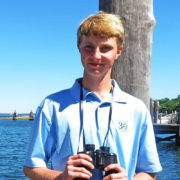
Olivia Backhaus
Olivia Backhaus, 21, lives in Stonington, CT. She first came to Fishers Island School in seventh grade and graduated in 2014. 2017 was her fifth summer working as a Sentinel for FIConservancy. Her interest in biology was sparked by the experiential nature of the science curriculum at FI School, which used the Island as a living laboratory for learning biology.
Olivia assumed a leadership position in 2016, training and overseeing members of the Sentinel team and assisting with other FIConservancy programs, such as Nature Days. She also spent the summer collating and analyzing daily data collected by the Sentinels and by Justine. Working as a Sentinel has inspired Olivia to major in Biology and minor in Environmental Studies at Sewanee: The University of the South. In the future, she plans to practice environmental law.

Gardner Thors
Gardner Thors, 15, lives in New York City and is a sophomore at Groton School in Massachusetts. He has been a Sentinel for three years, after first volunteering for one summer. As a city kid, he doesn’t get to experience nature and wildlife except for the landscaped Central Park and the infamous pigeons and squirrels of the city. Fishers Island is his wildlife sanctuary. Gardner has been summering here for as long as he can remember, and Fishers holds a special place in his heart. That is why he chose to play a part in the preservation of this environment. Gardner looks forward to learning more about the Island’s ecosystems and sharing what he learns with the Island community. His brother, Wilson, is also a passionate Sentinel.

Wilson Thors
Wilson Thors lives in New York City and is a freshman at Groton School in Massachusetts. 2017 was his first summer as a Sentinel, although he volunteered to monitor for FIConservancy last year. He joined the Sentinel program, because he was curious about his brother’s experiences as a Sentinel. Wilson has always appreciated the natural beauty of Fishers Island, but now he has a deeper love of the Island since learning more about animals and learning that we share this great place with the wildlife.

Kain Upson
Kain Upson grew up summering on Fishers Island, surrounded by the wildlife he now has the privilege of monitoring. 2017 was his first summer as an Island Sentinel. His special interest in biology, and eventually environmental biology, began during his senior year in high school, when a “fantastic” biology teacher was able to steer him in the right scientific direction. He is looking forward to sharing many more summers with the returning migratory and resident animals, who call Fishers Island home.

Conor Wakeman
Conor Wakeman, 19, of Greenwich, Conn., grew up summering on Fishers Island and is a sophomore at University of Pennsylvania studying economics. Conor spent three years as an Island Sentinel and was an emeritus Sentinel in 2017. After seeing an article about Justine Kibbe’s conservation efforts on the Island, he decided to use his love for the environment and wildlife science to help improve the ecological wellbeing of Fishers Island.
Since he loves spending time with nature and watching animals, Conor thought it was a great opportunity to collect data that would help understand this unique environment. During his time as a Sentinel, he worked on improving the efficiency of data collection and helped facilitate research about organizations such as Woods Hole Oceanographic Institute. With his expanding knowledge of the local ecosystem and shifting animal populations, he hopes to raise awareness of FIConservancy and help preserve the Island’s pristine environment.